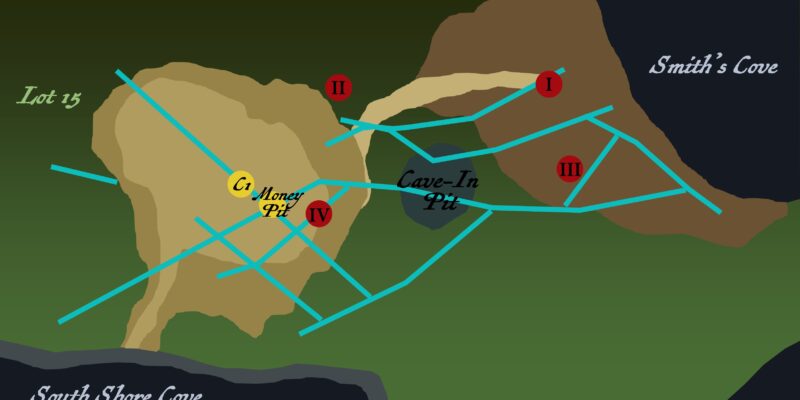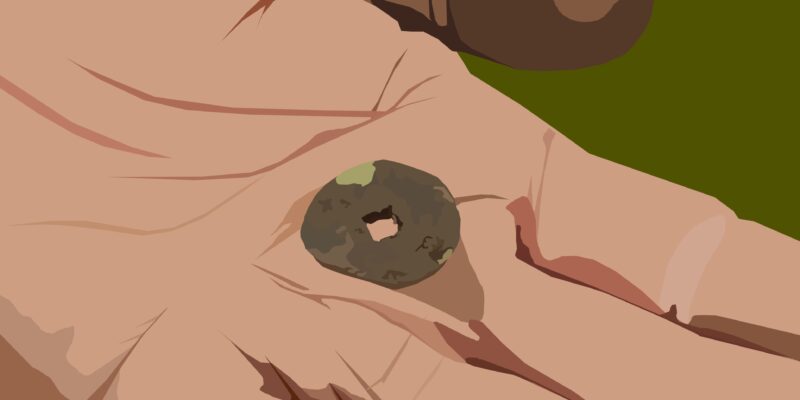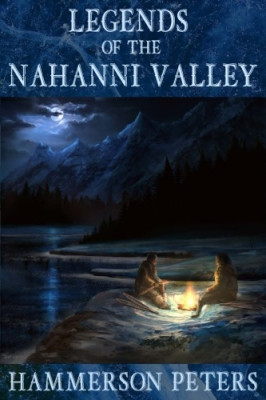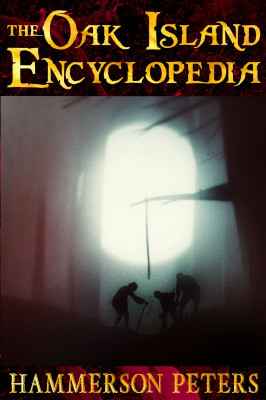The Curse of Oak Island- Season 8, Episode 2: The Boys are Back
The following is a plot summary and analysis of Season 8, Episode 2 of the History Channel’s TV series The Curse of Oak Island.
[SPOILER ALERT!!!]
Plot Summary
The first scenes in this episodes are homemade videos shot by Rick and Marty Lagina, Alex Lagina, and Peter Fornetti while they wait out their government-mandated 14-day quarantine in their homes on the mainland, two weeks of self-isolation being a legal requirement for any American visitors to Canada who cross the border during the COVID-19 pandemic. The treasure hunters kill time by exercising, planting trees, playing a First Nations-style skin drum, and engaging in a backyard construction project.
Back on Oak Island, archaeologists Laird Niven, Aaron Taylor, and David MacInnes resume their excavation of the mysterious stone walls on Lot 15. Taylor unearths a large flat stone with what appears to be a beveled edge and a hole drilled into its surface. The narrator then remarks that a number of drilled stones have been discovered on Oak Island over the years.

Laird Niven calls up Steve Guptill and informs him of the find. The surveyor visits the dig site, inspects the stone, and suggests that they call up Rick and Marty Lagina and tell them about it. Niven takes Guptill’s suggestion and phones the Lagina brothers. During the subsequent phone conversation, Guptill discloses that the artifact appears to resemble an old survey marker, and suggests that it may have some connection with the other drilled stones which lie scattered across the island. David MacInnes concurs with Guptill’s assessment, stating that he suspects the flat drilled stone was placed before those which comprise the walls beside which it was found.
The next day, Doug Crowell and Steve Guptill head to Smith’s Cove. While the treasure hunters unpack equipment from their truck, the narrator informs us that the Barringer Survey, first mentioned in the previous episode, indicates the presence of four 100-foot-deep deposits of non-ferrous metal on Oak Island. Crowell and Guptill hope to re-locate two of these deposits, both of which lie beneath Smith’s Cove, and drive stakes into the ground along the lines of the various underground tunnels which the survey indicates run through the area.

First, the treasure hunters sink a stake at spot at which one tunnel is believed to enter the Cave-In Pit. Immediately afterwards, Steve Guptill wades into the water at Smith’s Cove and hammers a stake into the spot at which that same tunnel is believed to end. The surveyor remarks that this is exactly the same spot at which Gary Drayton and Rick Lagina discovered the mysterious lead cross back in Season 5, Episode 10.
Next, Crowell and Guptill sink a stake into the spot at which one of the four aforementioned non-ferrous deposits is supposed to lie. As Guptill hammers on the stake, Crowell remarks that this location lies directly south of the Uplands Pit which Oak Island Tours Inc. dug to a depth of around 50 feet with a long-armed excavator in Season 7, from Episodes 14-17. “We were in the right zone, according to the Barringer Survey” he says. “We just didn’t know it.” The narrator then remarks that, at the end of Season 7, Episode 17, the Fellowship of the Dig intersected what they suspected might be a tunnel- perhaps the Smith’s Cove flood tunnel- at a depth of 50 feet in the Uplands Pit, but were forced to abandon their excavation shortly thereafter due to the instability of their shaft. The treasure hunters finish their operation by calling up the Lagina brothers and informing them of the orientation of the various points of interest indicated by the Barringer Survey in relation to other features on the island.

Later that afternoon, Jack Begley and Gary Drayton head to Isaac’s Point, on Oak Island’s easternmost end, to do some old-fashioned metal detecting. The pair quickly uncovers a pewter spoon bowl which Drayton dates to the mid-1700s. This is the second pewter spoon bowl discovered on Oak Island; Drayton found a similar artifact tangled in the roots of a tree on Lot 24 back in Season 5, Episode 3.

Shortly thereafter, the treasure hunters find the head of what Drayton identifies as a tunneling pick. The narrator suggests that this artifact bears resemblance to the rock hammer found in the spoils of Borehole RF1 in Season 7, Episode 21, which blacksmithing expert Carmen Legge suggested could be many centuries old. Recall that another pickaxe head was found near the Eye of the Swamp in Season 7, Episode 13, and that Carmen Legge dated that artifact to the mid-to-late-1700s.

Later that day, Steve Guptill sifts through spoils from caisson 8A with Josh Ballard and Michael John of Gerhardt Property Improvement, 8A being a shaft sunk back in Season 7, Episode 19 at the supposed junction of the Money Pit and the Shaft 6 tunnel. Recall that in Season 7, Episode 20, the treasure hunters discovered timbers, a mysterious needle identified as either a sailing cloth needle or a component of a trou de loup-style booby trap, a piece of a possible strap hinge, and many tiny scraps of leather in batches of 8A spoils taken from depths of 103-114 feet.

While searching through the 8A spoils at the wash table, Josh Ballard discovers a brown button apparently made of wood or horn, which Guptill believes belonged to a searcher. Shortly thereafter, Michael John finds a large piece of what appears to be leather, which Guptill enthusiastically suggests might be a relic of the original Money Pit depositors. The narrator then remarks that this latest discovery, when considered in conjunction with all the pieces of leather, parchment, and paper found at depth in the Money Pit area over the years, hints at the possibility that the Money Pit treasure consists of priceless documents.
Steve Guptill phones up Laird Niven and informs him of the leather which John discovered. The archaeologist heads over to the wash table and examines the artifact. Niven observes that the leather is not bonded, and suggests that it might be from a piece of footwear, evoking the antique leather shoes discovered at Smith’s Cove by Dan Blankenship in the 1970s.

The next day, Rick and Marty Lagina, Alex Lagina, and Peter Fornetti conclude their 14-day quarantine and drive to the Oak Island Research Centre, where they meet with Charles Barkhouse and Doug Crowell. The Oak Island historians promptly take the treasure hunters to the rock formation on Lot 15, which the archaeologists are busy excavating. David MacInnes greets the newcomers and explains that the feature is not the entrance of the tunnel as first hoped. Aaron Taylor than voices his and MacInnes’ opinion that the structure constitutes the remains of a pine tar kiln. Laird Niven then chimes in with an interesting statement, saying “We always assumed that this was for marine purposes, but it could have been used for construction of the Money Pit.” The archaeologists then suggests that the mysterious lights which legend says once flickered on Oak Island in the dead of night were fires from this tar kiln.

Meanwhile, Alex Lagina and Jack Begley drive to the Northville Farm Heritage Centre in Centreville, Nova Scotia- apparently, the new workplace of blacksmithing expert Carmen Legge. The treasure hunters find the blacksmith in his new shop and show him the pickaxe head which Jack and Gary Drayton discovered earlier at Isaac’s Point. Legge dates the artifact to the late 1700s or early 1800s, suggesting that it was deposited by either searchers or island residents. The blacksmithing expert points out a stress fracture in the iron, which he says indicates that the tool was used for “heavy, heavy major pounding and hitting… Whoever used this and broke it were meaning business.”

That evening, the Fellowship of the Dig congregates in the War Room. Marty Lagina playfully chastises Gary Drayton for withholding the nature of the “top pocket find” which he and Jack Begley made the previous episode on Oak Island’s Lot 15. Before making the big reveal, Gary Drayton shows his fellow treasure hunters the axe head which he and Jack made prior to their important discovery. While the object is passed around the table, we learn that both Gary Drayton and Laird Niven believe the artifact dates to the early 1700s. Next, Drayton withdraws the coin with the square hole through its middle- the “top pocket find”- from his breast pocket and passes it to Rick Lagina. He explains that the coin is made of copper, and that faint embossing is visible on its faces. “To me,” the treasure hunter explains, “when you find a coin with a square hole in it, like that, it’s an old colonial era coin. The locals decided to deface it… Who’s to say this isn’t from 16/ early 1700s, or even older.”Drayton’s comment evokes his assessment of an old perforated token discovered in the swamp in Season 6, Episode 21, namely that the artifact is a 17th or 18th Century coin through which some disgruntled North American colonist drove a square nail in protest of the reigning monarch.

Analysis
The Flat Drilled Stone
In this episode, archaeologists Laird Niven, Aaron Taylor, and David MacInnes unearthed a large flat stone near the stone structure on Lot 15. This stone appeared to have a beveled edge and a hole drilled into its upper face. Steve Guptill later examined the artifact and concluded that it was an old survey marker.

As was mentioned briefly in the show, this artifact is not the first drilled stone to be found on Oak Island. In 1895, treasure hunter Frederick Blair discovered a drilled boulder northeast of the Money Pit area. In the late 1930s, Gilbert Hedden discovered a similar drilled stone on Smith’s Cove. These strange landmarks feature in one of the most bizarre chapters in the history of the Oak Island treasure hunt, the curious saga of the Wilkins Map.
During his own Oak Island treasure hunt in the 1970s and ‘80s, Dan Blankenship discovered three drilled stones similar in appearance to those found previously north of the Money Pit area.
In Season 3, Episode 11 of The Curse of Oak Island, engineers Mike and Sean Herold, while testing the theory of their friend, the late Laverne Johnson, stumbled upon a drilled rock north of the Money Pit area.
In Season 6, Episode 1, Jack Begley and Gary Drayton discovered a large granite boulder on Oak Island’s Lot 2 in which a hole had been drilled and an iron spike embedded. Drayton initially suspected that the spike and hole constituted the remains of a ring bolt through which a chain or rope had been threaded for the purpose of hauling heavy objects. In a special episode featuring cutting-room footage which preceded the airing of the Season 7 premiere, entitled ‘The Top 25 Moments You Never Saw’, we learned that Laird Niven believes this stone to be evidence of a failed quarrying operation. Presumably, Niven believes that men had drilled holes into the stone and hammered an iron spike into it in an effort to split it in two, hoping to incorporate the fractured pieces into the foundation of some structure.
The Uplands Pit
In this episode, Doug Crowell and Steve Guptill sink stakes at various points of interest indicated by the Barringer Survey. While sinking a stake at the location of a supposed 100-foot-deep deposit of non-ferrous metal, Doug Crowell remarks that this location lies directly south of the Uplands Pit dug throughout Season 7. Guptill later confirms that the alleged deposit sits at the edge of the Uplands Pit, around where heavy equipment operator Billy Gerhardt sat in the cab of the excavator while digging the hole.
The Uplands Pit was first begun in Season 7, Episode 14 in an effort to locate the Smith’s Cove flood tunnel. That episode, the Fellowship uncovered old timbers and nails which Charles Barkhouse suggested might be the remains of an undocumented searcher shaft sunk by the Truro Syndicate, whose members searched for treasure on Oak Island in the mid-1800s.
In Season 7, Episode 15, the treasure hunters discovered coconut fibre in the Uplands Pit. Later that same episode, they unearthed what some suspected to be the remains of the Smith’s Cove flood tunnel, along with wood cribbing which Jack Begley believed to be the remains of Shaft 5, sunk by the Truro Company in 1850 for the purpose of intersecting and shutting off the flood tunnel.
In Season 7, Episode 16, the treasure hunters found two large iron spikes in the Uplands Pit, both of which Gary Drayton dated to the 1700s prior to the discovery of the Money Pit. Later that episode, Oak Island Tours Inc. brought a long-armed excavator to Oak Island. Billy Gerhardt used this machine to deepen the Uplands Pit. During this process, water began to pour into the hole. Shortly thereafter, a huge wall of earth broke free from the side of the pit and crashed into the water below. The hole slowly started to cave in, prompting the treasure hunters to backfill it for safety purposes and agree to abandon the excavation for the time being.

The treasure hunters re-opened the Uplands Pit in Season 7, Episode 17 and unearthed several timbers therein bearing great resemblance to those which comprise the U-Shaped Structure. Below these timbers were what appeared to be the remains of an underground tunnel. Unfortunately, due to the hazardous instability of the Uplands Pit, the treasure hunters were forced to terminate their excavation shortly after that discovery.
Where is Dave Blankenship?
If you’re a fan of Dave Blankenship, you may have noticed his conspicuous absence from both this episode and the Season 8 premiere. In private correspondence with this author, the essence of which Mr. Blankenship has given me permission to disclose in this video, Dave decided to distance himself from the show on account of the treatment which his father, the late Dan Blankenship, received from its producers. Specifically, Dave feels that his father was left out of too many important decisions and events. He also resents what he perceives to be the show’s habit of glossing over his father’s considerable achievements and the many trials, tribulations, and discoveries which characterized his 50-year-old treasure hunt, preferring to give other treasure hunters a proportionally undue spotlight. Dave used the word “retire” in his message, and so, while he may make the occasional appearance on the show, I’m afraid that we will probably see much less of him throughout Season 8.

Thanks for Reading!
Thanks for reading! If you enjoyed this article and would like to help support this website, please check out our online bookshop:
















Michel Duplin
Je considère illogique et immoral de repousser une ressource aussi polyvalente qu’est la famille Blankenship. Je ne peux pas croire que Rick ait accepté qu’un ou des individus, soit disant responsable de la série, ridiculise un ou des individus qui sont avec lui depuis le début de cette aventure. Si Rick déclare publiquement qu’il accepte de se défaire de personnes si impliquées dans cette recherche, je serais déçu et mon admiration pour cet homme perdrait beaucoup de valeur !!! Ils sont partie intégrale de l’ADN de Oak Island !!
Noel Blankenship
The Blankenship family history book is loaded with loads of names, relationships, (Dan, father of David….(and any other children) other info such as property records.
Noel Blankenship
444 Park Ave
Kent, Oh 44240′
PH: 330-673-1523
Noel Blankenship
To: Dave Blankenship
From: Noel Blankenship, professor emeritus
444 Park ave
Kent, Ohio 44240
Re: Blankenship Family History Book
I have greatly enjoyed seeing the Oak Island series for several yrs now, and don’t think there’s any mention of you or your Dad in either 1st or 2nd edition. 1st edition written by Col. Leslie Blankenship, and published by John Q, Blankenship, Press-Craft Printing , Inc. 2210 Royal street, New orleans, Lousiana 70117. The Blankenship Heritage Committee was at the same address.
2nd edition was written by Lee Ann Blankenship, my brother Barry’s wife, at 480 Carthage Ave, Kent, Oh 44240. ph: 330-221-6221, Barry is Kent’s retired Fire Chief. I think you can get a copy of 2nd edition directly from Lee Ann.
I’ve written 2 or 3 letters to you but they all came back undelivered….don’t know why, and hope you get this. Keep up the good work on the show!
Yours Truly,
Noel M. Blankenship, professor emeritus, Kent St Univ.
444 Park Ave
Kent, Oh 44240
Kerry Roberts
Shame about Dave. I loved his spunk and respected him for the fighter he is due to his medical condition!! Being from Oklahoma, we know hard times, which has made us a tough culture. Dave could easily be an Okie!! Take care Dave, and your dad was a man’s man and a true hero!!
Debra Barone
I can’t believe this is true! Dave’s father was so loved by many fans and when I watched the show, he is always mentioned and they all had so much respect for him and when he passed away, I couldn’t keep my eyes dry. I thought they did such a beautiful and respectful tribute to him. I can’t believe the producers would have down- played Dan Blankenship in anyway, We miss him and WE miss YOU, Dave Blankenship! Please come back on the show and pray all is well with you and your family!!